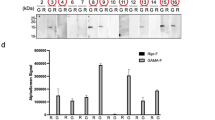Summary
The FLAG® peptides DYKDDDDK and MDYKDDDDK are widely used affinity tags. Here we describe new variants of the FLAG peptides which, in direct ELISA, showed selective and differential binding to the commercially available anti-FLAG monoclonal antibodies M1, M2 and M5. Variants of the FLAG peptides were synthesized on polymer-grafted plastic pins, and in an ELISA incubated with mAbs M1, M2 and M5. Among the newly identified tag sequences are those that bind only one of the anti-FLAG mAbs and those that bind only two or all three of the anti-FLAG mAbs. Examples of new tag sequences are MDFKDDDDK (which binds mAb M5 and does not bind mAbs M1 and M2) and MDYKAFDNL (which binds mAb M2 and does not bind mAbs M1 and M5). The sensitivity in direct ELISA of some variants was increased, e.g. using mAb M2 it was found that replacing DDDDK in MDYKDDDDK by AFDNL increased the sensitivity in ELISA at least 10-fold. The activity of this peptide was studied in more detail. In different direct ELISAs, in which MDYKAFDNL was synthesized on polyethylene pins, coated onto polystyrene microtiter plates or onto nitrocellulose paper, the activity of this peptide was similar, i.e. increased at least 10-fold over that of MDYKDDDDK. Remarkably, in competitive ELISA the binding activity of soluble MDYKAFDNL was decreased 10-fold over those of soluble MDYKDDDDK or DYKDDDDK. The results seem to suggest that, in solution, the conformation of MDYKAFDNL is more ‘unstructured’ compared to its conformation when coated or linked to a carrier. We postulate that the newly described tag sequences may be used as affinity tags to separately detect, quantify and purify multiple co-expressed proteins and/or subunits.
Similar content being viewed by others
Abbreviations
- ABTS:
-
2,2′-azino-di-3-ethylbenzthiazoline sulfonate
- ELISA:
-
enzyme-linked immunoabsorbent assay
- GDA:
-
glutardialdehyde
- HPLC:
-
high-performance liquid chromatography
- mAb:
-
monoclonal antibody
- rampo:
-
rabbit-anti-mouse peroxidase
- SDS:
-
sodium dodecylsulfate
References
Sassenfeld, H.M.,Engineering proteins for purification, Trends Biotechnol., 8 (1990) 88–93.
Jones, C., Patel, A., Griffin, S., Martin, J., Young, P., O'Donnell, K., Silverman, C., Porter, T. and Chaiken, I.,Current trends in molecular recognition and bioseparation, J. Chromatogr., 707 (1995) 3–22.
Tao, Y. and Chen, K.Y.,PCR-based cloning of the full-length Neurospora eukaryotic initiation factor 5A cDNA: Polyhistidine tagging and overexpression for protein affinity binding, Biochem. J., 302 (1994) 517–525.
Hopp, T.P., Prickett, K.S., Price, V.L., Libby, R.T., March, C.J., Cerretti, D.P., Urdal, D.L. and Conlon, P.J.,A short polypeptide tag sequence useful for recombinant protein identification and purification, Biotechnology, 6 (1988) 1204–1210.
Prickett, K.S., Amberg, D.C. and Hopp, T.P.,A Ca 2+-dependent antibody for identification and purification of recombinant proteins, Biotechniques, 7 (1989) 580–589.
Tate, C.G. and Blakely, R.D.,The effect of N-linked glycosylation on activity of the Na(+)-and Cl(-)-dependent serotonin transporter expressed using recombinant baculovirus in insect cells, J. Biol. Chem., 269 (1994) 26303–26310.
Light, A. and Janska, H.,Enterokinase (enteropeptidase): Comparative aspects, Trends Biochem. Sci., 14 (1989) 110–112.
Knappik, A. and Plückthun, A.,An improved affinity tag based on the FLAG® peptide for the detection and purification of recombinant antibody fragments, Biotechniques, 17 (1994) 754–761.
Pinilla, C., Buencamino, J., Appel, J.R., Hopp, T.P. and Houghten, R.A.,Mapping the detailed specificity of a Ca 2+-dependent monoclonal antibody through the use of soluble positional scanning combinatorial libraries: Identification of potent Ca2+-independent antigens, Mol. Diversity, 1 (1995) 21–28.
Huang, S., Elliott, R.C., Liu, P.S., Koduri, R.K., Weickmann, J.L., Lee, J.H., Blair, L.C., Ghosh-Dastidar, P., Bradshaw, R.A. and Bryan, K.M.,Specificity of cotranslational amino-terminal processing of proteins in yeast, Biochemistry, 26 (1987) 8242–8246.
Hirel, P.-H., Schmitter, J.-M., Dessen, P., Fayat, G. and Blanquet, S.,Extent of N-terminal methionine excision from Escherichia coli proteins is governed by the side-chain length of the penultimate amino acid, Proc. Natl. Acad. Sci. USA, 86 (1989) 8247–8251.
Dalboge, H., Bayne, S. and Pedersen, J.,In vivo processing of N-terminal methionine in E. coli, FEBS Lett., 266 (1990) 1–3.
Geysen, H.M., Meloen, R.H. and Barteling, S.J.,Use of peptide synthesis to probe viral antigens for epitopes to a resolution of a single amino acid, Proc. Natl. Acad. Sci. USA, 81 (1984) 3998–4002.
Langeveld, J.P.M., Casal, J.I., Osterhaus, A.D.M.E., Cortes, E., De Swart, R., Vela, C., Dalsgaard, K., Puijk, W.C., Schaaper, W.M.M. and Meloen, R.H.,First peptide vaccine providing protection against viral infection in the target animal: Studies of canine parvovirus in dogs, J. Virol., 68 (1994) 4506–4513.
Li, K.W., Geraerts, W.P.M., Van Elk, R. and Joosse, J.,Dot-immunobinding of high performance liquid Chromatographic fractions on poly(vinylidene difluoride) membrane, J. Chromatogr., 472 (1989) 445–446.
DeBlas, A. and Cherwinski, H.M.,Detection of antigens on nitrocellulose paper immunoblot with monoclonal antibodies, Anal. Biochem., 133 (1983) 214–219.
Miceli, R.M., De Graaf, M.E. and Fischer, H.D.,Two-stage selection of sequences from a random phage display library delineates both core residues and permitted structural range within an epitope, J. Immunol. Meth., 167 (1994) 279–287.
Stockman, B.J., Bannow, C.A., Miceli, R.M., De Graaf, M.E., Fischer, H.D. and Smith, C.W.,Chemical shift differences between free and Fab-bound peptide correlate with a two-stage selection of peptide sequences from a random phage display library to delineate critical and non-critical residues for antibody recognition, Int. J. Pept. Protein Res., 45 (1995) 11–16.
Schäfer, K. and Braun, T.,Monoclonal anti-FLAG antibodies react with a new isoform of rat Mg 2+-dependent protein phosphatase beta, Biochem. Biophys. Res. Commun., 207 (1995) 708–711.
Lang, E., Szendrei, G.I., Lee, V.M. and Otvos Jr., L.,Spectroscopic evidence that monoclonal antibodies recognize the dominant conformation of medium-sized synthetic peptides, J. Immunol. Meth., 170 (1994) 103–115.
Mattioli, S., Imberti, L., Stellini, R. and Primi, D.,Mimicry of the immunodominant conformation-dependent antigenic site of hepatitis A virus by motifs linselected from synthetic peptide libraries, J. Virol., 69 (1995) 5294–5299.
Author information
Authors and Affiliations
Rights and permissions
About this article
Cite this article
Slootstra, J.W., Kuperus, D., Plückthun, A. et al. Identification of new tag sequences with differential and selective recognition properties for the anti-FLAG monoclonal antibodies M1, M2 and M5. Mol Divers 2, 156–164 (1997). https://doi.org/10.1007/BF01682203
Received:
Accepted:
Issue Date:
DOI: https://doi.org/10.1007/BF01682203




